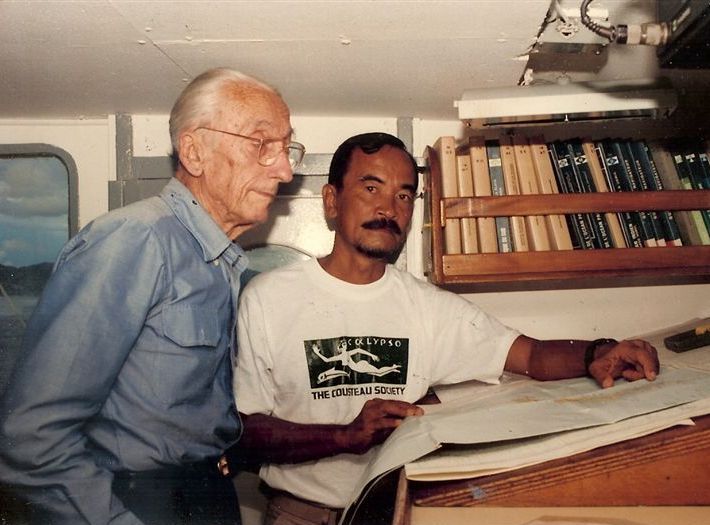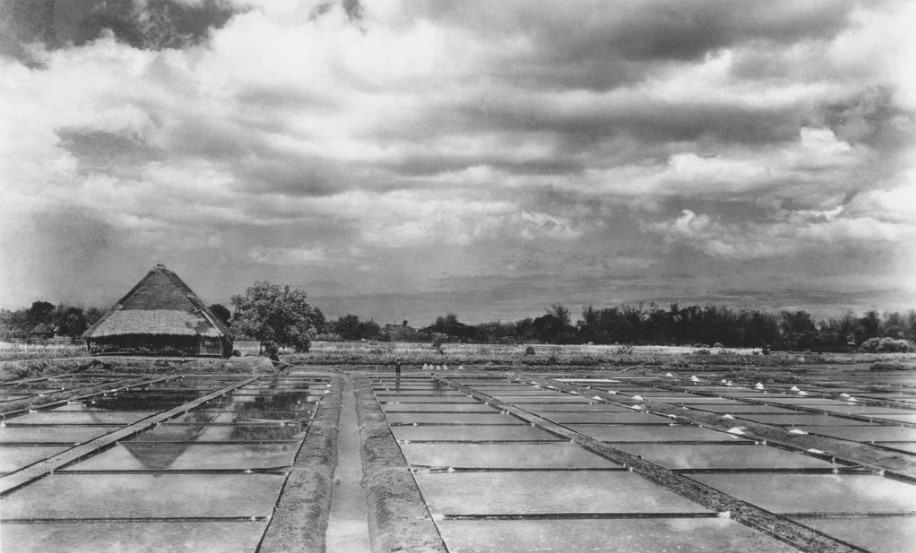

A PASSAGE OF AN ARTIST
THRU TIME AND SPACE
by Popoy Castañeda

Popoy, the diver and guide, and the legendary Jacques-Yves Costeau study Palawan's hydrographic chart.
[See: A Betan's Journey Thru Time and Space, in Memoirs & Reminiscences]
Part 1a - Palanyag
1940
My earliest memories of childhood is in Palanyag (now Parañaque city). My
father, Dominador Castañeda, who was teaching painting at the University of the
Philippines School of Fine Arts, then at the Padre Faura campus, chose to stay
in Palanyag. It was not just as a concession to my mother, whose family was
from there, but more so for the beauty of the place which appealed to his
artistic taste and his painting endeavors. Palanyag, 12 kilometers or more south
of Manila, was then a small semirural town squeezed between the shores of Manila
Bay and a sprawling complex of tidal rivers, mangrove swamps, saltbeds,
fishponds and rice farms.The natives of Palanyag spoke with a singsong accent
which is still carried on today by the older inhabitants who are identified by
this peculiar accent.
Palanyag was the place if people wanted to go to the beach or simply buy fresh
fish oysters and sea salt. We lived in the barrio (now a barangay) of La Huerta
in an old Spanish house among my maternal aunts and uncles. At the east approach
to the town plaza was a bambooed roof structure, about 3 x 4 meters, where the
sabungeros (cockfighters) gathered. Don Manuel Bernabe, the Spanish poet
laureate who composed "No Mas Amor Que El Tuyo", a native of La Huerta and an
avid sabungero, would approach and talk to my father. Don Manuel always
conversed with my father in Spanish. I distinctly
remember to this day going to the beach, just a 4-minute stroll away, with my
father almost everyday in the morning when he didn't have a class or in the
afternoon after his classes in Padre Faura. He would always have with him his
sketch pad for his charcoal and pencil sketches, or a watercolor pad with his
watercolor pans and a jar of water, or his oil sketching palette box.
On the beach he would allow me to play by his side while he worked on his
sketches. When it was low tide he would allow me to wade in the shallow tidal
flats searching for crabs and clams. But most of the time he would go with me
pointing to me the crabs, small fishes, jellyfishes and small octopus which all
escaped my eyes. My father was then the only resident artist of La Huerta and
was familiar to the fishermen, the saltbed workers and the rice farmers in our
locality. On the beach we were even allowed by the caretakers of the fish
corrals to wade inside the corrals where the fishes and crabs were plentiful.
To these people my father was "Mang Doming" and they even allowed him to sketch them. Some of them who knew my mother would give us fresh fish. During the months of May and June, when the tide was extremely low, my father would dispense with his painting paraphernalia and go with me to the sandbars to look for and gather clams and cockle shells. At other times, especially during the dry season, we would go to the saltbeds which were bordered by mangroves and to Lolo Pitong’s farm, a full 60 minutes walk from our house in La Huerta. There my father introduced me to the world of kingfishers, herons, snipes, green snakes and mudcrabs. I would see schools of bangus (milkfish) churning the waters of their impounding fishponds. Later in the afternoon we would watch the saltworkers harvest the salt from the evaporating pans. Later when the sky reddened at the west my father would take out his sketch pad and capture the magical beauty of the clouds at sunset.

Parañaque saltbeds
(To be continued)
Links:
o Part 1 - My Life in La Huerta
Back ---> Memoirs & Reminiscenses)